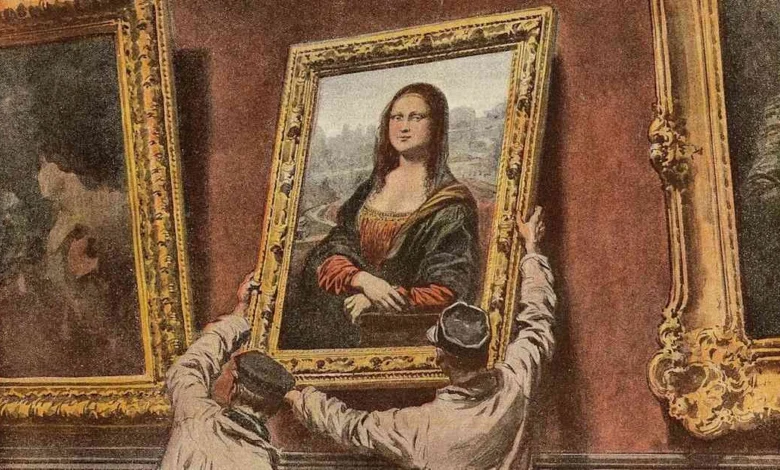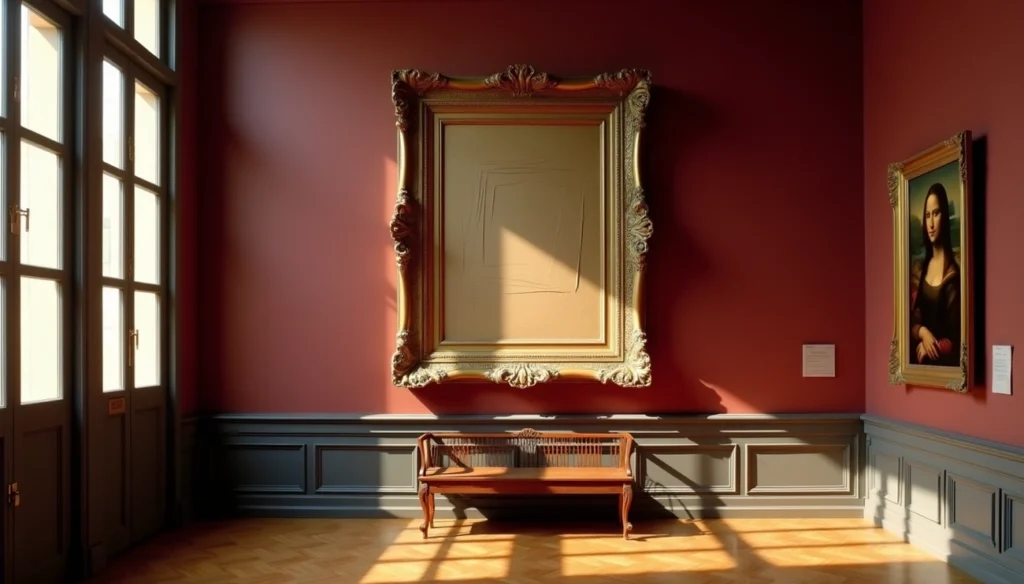
From War Loot to Modern Intrigue: The Mona Lisa’s Most Puzzling Disappearance Yet
The Mona Lisa wasn’t always the iconic masterpiece we know today. A simple act changed everything at the time of August 21, 1911. Italian handyman Vincenzo Peruggia pulled off one of the boldest art heists in history – he just walked out of the Louver with Leonardo da Vinci’s painting under his coat. Nobody noticed anything was wrong until the next day, when a painter showed up to copy the artwork and found nothing but an empty space on the wall.
Back then, people didn’t think much of the painting compared to how we see it now. The theft changed everything and shot the Mona Lisa to worldwide fame. Newspapers everywhere screamed “The Mona Lisa has been stolen!”. Staff searched every corner of the museum, questioned everyone, and dug through all the archives. Still, the painting stayed hidden for two years. The story took a turn in 1913 when Peruggia tried to sell it in Florence. He claimed he did it all for love of his native Italy.
This piece tells the story of the world’s most famous portrait. The sort of thing I love is how one theft reshaped art history completely – from its disappearance in 1911 to close calls with Nazi looters in World War II, right up to becoming a modern viral sensation. The Mona Lisa’s tale shows how a single crime turned a painting into the cultural icon we know today.
The 1911 Mona Lisa Heist: A Theft That Changed Art History

“You might as well pretend that one could steal the towers of Notre Dame.” — Head of French museums (1911), Senior French cultural official overseeing national museums during the Mona Lisa theft
The Louver stood quiet that Monday morning on August 21, 1911. Vincenzo Peruggia pulled off what experts call the greatest art heist of the 20th century. He walked through a staff door wearing a white worker’s smock that made him blend right in with other museum employees.
How Vincenzo Peruggia pulled it off
This 29-year-old Italian handyman knew the Louver’s layout well. He had installed protective glass cases there, including the one that protected the monalisa painting. He waited until the Salon Carré emptied out. The theft proved surprisingly simple – he lifted the artwork from its four iron pegs, took it to a nearby stairwell to remove the frame, and hid it under his clothes. A passing plumber saw him struggling with a locked exit door and helped unlock it, thinking Peruggia was just another staff member.
Why the theft went unnoticed for a day
The monalisa picture’s disappearance remained undetected for more than 24 hours. The Louver’s security was minimal back then – just 200 guards watched over 400 rooms, and the museum barely had any alarm systems. The guards didn’t worry about the empty space since artwork often moved around for photography or maintenance.
The global manhunt and false leads
News of the missing painting created a media storm. The New York Times ran the headline “60 detectives seek stolen Mona Lisa, French public indignant”. French authorities shut the borders, searched every ship and train, and questioned all museum employees. People speculated wildly – some blamed wealthy American collectors, while others suspected the German Kaiser had ordered the theft.
The role of Picasso and other suspects
A young Pablo Picasso became one of the most fascinating suspects. Though innocent of the monalisa photo theft, both Picasso and poet Guillaume Apollinaire faced questioning. They had bought stolen Iberian statues from the Louver earlier. The court case took an dramatic turn when Apollinaire confessed while Picasso broke down crying and denied knowing him. The judge dismissed the case.
How the painting was finally recovered
The monalisa stayed hidden in Peruggia’s Paris apartment trunk for two years. The story took a turn in December 1913 when Peruggia reached out to Italian art dealer Alfredo Geri using the name “Leonardo”. Geri met him in Florence with the Uffizi Gallery’s director. They confirmed the painting’s authenticity and called the authorities. Peruggia claimed patriotic motives and spent just seven months in prison.
From War to Wartime: The Nazi Looting of the Louver
Jacques Jaujard arranged one of history’s greatest art evacuations before the Nazis marched into Paris. He closed the Louver for “repairs” in August 1939 and secretly started emptying the museum’s treasures.
How Jacques Jaujard saved the collection
The core team packed 1,862 wooden cases with priceless artworks under Jaujard’s leadership. They used a clever marking system: yellow circles for valuable pieces, green for major works, and red for world treasures. The monalisa painting earned three red circles that showed its supreme importance. A fleet of 203 vehicles transported these treasures to French castles across the country. Jaujard moved pieces like the monalisa between châteaux throughout the war to avoid detection.
What the Nazis managed to steal
Count Franz Wolff-Metternich arrived in Paris on August 16, 1940, only to find an empty museum. The Nazis still managed to loot 100,000 objects from France during the occupation, mostly from Jewish families. They gave some artworks to their fascist allies, including Bartolomé Estaban Murillo’s “The Immaculate Conception of Los Venerables”.
The fate of looted artworks post-WWII
France recovered about 61,000 stolen pieces by 1949. Original owners successfully claimed 45,000 of these works. The Louver currently holds around 1,600 works marked “MNR” (Musées Nationaux Récupération) while waiting for rightful claimants. Only about 100 objects have found their way back to their owners or descendants since the 1950s.
Modern-Day Thefts and Security Failures
The Louver’s security history goes beyond its famous monalisa theft, with several major breaches in modern times.
The 1976 sword and 1990s painting thefts
Three masked burglars made their way up the support structure and broke second-floor windows in December 1976. They stole King Charles X’s diamond-studded coronation sword from the Apollo Gallery—a crime that remains unsolved today. The 1990s brought more trouble as thieves cut a small Renoir painting right from its frame in broad daylight and took 12 pieces of Roman jewelry. The museum faced another bold theft in 1998 when someone cut Corot’s “Le Chemin de Sevres” from its frame, which led to a complete security upgrade.
The 2025 jewel heist in broad daylight
The museum suffered a dramatic seven-minute heist in October 2025. Four masked thieves used a mechanical lift to enter the Galerie d’Apollon through a window. They threatened the guards with power tools and smashed display cases holding royal treasures. The group escaped on motorbikes with eight irreplaceable items, including Napoleon’s emerald necklace and several diamond-encrusted pieces. The thieves dropped Empress Eugénie’s crown, which contained over 1,300 diamonds, during their getaway.
How security audits exposed vulnerabilities
Security audits revealed serious problems: 75% of the Richelieu wing had no video surveillance. The core team decreased from 994 in 2014 to 856 in 2023, and a local alarm system wasn’t working. The world’s most-visited museum, home to the famous monalisa painting, now faces basic security challenges that need immediate attention.
The Mona Lisa’s Enduring Mystique and Viral Fame
The 1911 theft turned the monalisa painting into a global sensation. Nobody paid much attention to the artwork before it disappeared. The newspapers worldwide printed its image afterward, and people started recognizing it instantly.
How the theft made the monalisa painting iconic
The monalisa shot to unprecedented fame after the theft. Very few people knew about the painting outside art circles before 1911. Millions saw its reproductions in newspapers, and it became a household name. People lined up in record numbers to see the recovered masterpiece when it returned to the Louver in 1914.
Mona Lisa vandalism and protest incidents
The monalisa picture faced several attacks through the years:
- A man damaged the lower portion with acid in 1956
- Another visitor chipped paint near the left elbow with a rock that same year
- A woman protesting museum policies sprayed red paint during its Tokyo visit in 1974
- A Russian woman’s ceramic cup shattered against the bulletproof glass in 2009
The rise of monalisa viral girl and meme culture
The monalisa viral phenomenon took off online with endless parodies and remixes. Young women copied the famous mysterious smile in social media challenges during the “monalisa viral girl” trend of 2023.
Why the monalisa photo still engages millions
The monalisa photo draws more than 10 million visitors each year. People find it fascinating because of the subject’s mysterious identity, the groundbreaking sfumato technique, that enigmatic smile, and its reputation as the world’s most famous stolen artwork.
The Mona Lisa represents much more than a Renaissance masterpiece today. This enigmatic portrait’s remarkable story transformed it from a stolen artwork hidden in a Paris apartment into the world’s most recognizable painting. The 1911 theft proved to be a turning point that launched the painting from relative obscurity to international fame. Media outlets across the globe printed its image and permanently embedded it in public consciousness.
The painting’s survival during World War II adds another remarkable chapter to its history. The meticulous evacuation plan by Jacques Jaujard protected countless treasures, including the Mona Lisa, from Nazi confiscation. This dramatic wartime rescue strengthens the painting’s mystique and historical significance.
Security issues still challenge the Louver despite its priceless collection. Multiple thefts across decades expose vulnerabilities that exist even in the world’s most famous museum. In spite of that, these incidents have only boosted public fascination with both the institution and its most famous resident.
The Mona Lisa stands apart through its unique cultural effect. The painting has endured as both a physical artwork and a powerful symbol, surviving everything from acid attacks to viral social media trends. The enigmatic smile that engaged Leonardo da Vinci’s contemporaries now attracts millions of yearly visitors who brave crowds to witness artistic history.
This modest portrait’s transformation from war loot to modern internet phenomenon shows how our relationship with art and celebrity has evolved. Though nearly destroyed multiple times, stolen once, and constantly under threat, the Mona Lisa’s appeal keeps growing stronger. Maybe even this resilience explains why her mysterious smile still engages us after five centuries, surpassing time as both artistic treasure and cultural touchstone.






